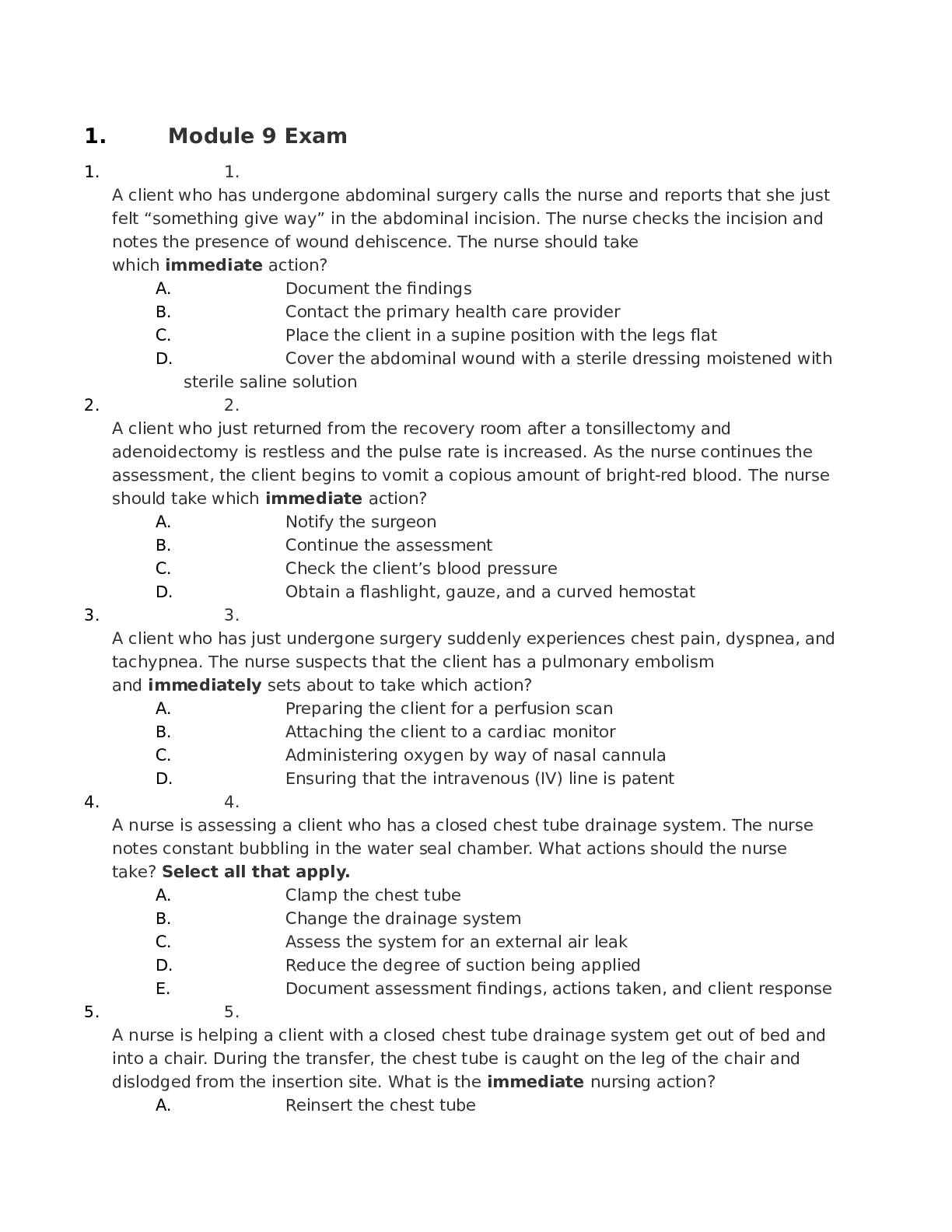NURSING NCLEX Module 9 Exam Questions and Answers,100% CORRECT
Document Content and Description Below
NURSING NCLEX Module 9 Exam Questions and Answers Submission Details • Submission Date: 2/15/2017 • Submission Time: 10:24 PM • Points Awarded: 100 • Points Missed: 1 • Number of Att... empts Allowed: 1 • Not Scored: 0 • Percentage: 99.01% 1. Questions 1. 1.ID: 9477077870 A nurse performing a physical assessment of a client gathers both subjective and objective data. Which finding would the nurse document as subjective data? A. The client appears anxious. B. Blood pressure is 170/80 mm Hg. C. The client states that he has a rash. Correct D. The client has diminished reflexes in the legs. Awarded 1.0 points out of 1.0 possible points. 2. 2.ID: 9477073956 A nurse is reviewing the findings of a physical examination that have been documented in a client's record. Which piece of information does the nurse recognize as objective data? A. The client is allergic to strawberries. B. The last menstrual period was 30 days ago. C. The client takes acetaminophen (Tylenol) for headaches. D. A 1 × 2inch scar is present on the lower right portion of the abdomen. Correct Awarded 1.0 points out of 1.0 possible points. 3. 3.ID: 9477071188 A nurse is making an initial home visit to a client with chronic obstructive pulmonary disease who was recently discharged from the hospital. Which type of database does the nurse use to obtain information from the client? A. Episodic B. Followup C. Emergency D. Complete Correct Awarded 1.0 points out of 1.0 possible points. 4. 4.ID: 9477071128 A nurse is examining a 25yearold client who was seen in the clinic 2 weeks ago for symptoms of a cold and is now complaining of chest congestion and cough. The nurse should proceed with the examination by collecting which? A. Data related to followup care B. A complete (total health) database C. Data related to the respiratory system Correct D. Data related to the treatment for the cold Awarded 1.0 points out of 1.0 possible points. 5. 5.ID: 9477071111 A client is brought to the emergency department after a motor vehicle accident. The client is alert and cooperative but has sustained multiple fractures of the legs. How should the nurse proceed with data collection? A. Collect health history information first, then perform the physical examination B. Ask health history questions while performing the examination and initiating emergency measures Correct C. Collect all information requested on the history form, including social support, strengths, and coping patterns D. Perform emergency measures and not ask any health history questions until the client's fractures have been treated in the operating room Awarded 1.0 points out of 1.0 possible points. 6. 6.ID: 9477073919 A client who was given a diagnosis of hypertension 3 months ago is at the clinic for a checkup. Which type of database does the nurse use in performing an assessment? A. Emergency B. Followup Correct C. Complete (total) D. Problemcentered Awarded 1.0 points out of 1.0 possible points. 7. 7.ID: 9477073943 A MexicanAmerican client with epilepsy is being seen at the clinic for an initial examination. What is the primary purpose of including cultural information in the health assessment? A. Confirm the medical diagnosis B. Make accurate nursing diagnoses C. Identify any hereditary traits related to the epilepsy D. Determine what the client believes has caused the epilepsy Correct Awarded 1.0 points out of 1.0 possible points. 8. 8.ID: 9477071171 A nurse performing a skin assessment uses the back of the hand to feel the client's skin on both arms and notes that the skin is warm. What does the nurse determine? A. The client has a fever B. The skin temperature is normal Correct C. The client needs to drink additional fluids D. The client needs to have the blanket removed Awarded 1.0 points out of 1.0 possible points. 9. 9.ID: 9477071124 A nurse performing a skin assessment notes that the client's skin is very dry. How should the nurse document this finding? A. Xerosis Correct B. Pruritus C. Seborrhea D. Actinic keratoses Awarded 1.0 points out of 1.0 possible points. 10. 10.ID: 9477073962 A nurse is preparing to perform a skin examination with the use of a Wood light. Which action should the nurse perform to prepare for this diagnostic test? A. Darken the room Correct B. Obtain informed consent from the client C. Obtain a scalpel and a slide for diagnostic evaluation D. Obtain medication to anesthetize the skin area before proceeding with the examination Awarded 1.0 points out of 1.0 possible points. 11. 11.ID: 9477067490 A nurse performing an assessment of a client with kidney failure notes that the client has the appearance of generalized edema over the entire body. How should the nurse document this finding? A. Anasarca Correct B. Ecchymosis C. Unilateral edema D. Increased vascularity of the skin tissue Awarded 1.0 points out of 1.0 possible points. 12. 12.ID: 9477071176 A nurse reviewing the medical record of a client with the diagnosis of heart failure notes documentation indicating that the client has deep pitting edema, that the indentation remains for a short time, and that the leg looks swollen. How should the nurse document this finding? A. 1+ edema B. 2+ edema C. 3+ edema Correct D. 4+ edema Awarded 1.0 points out of 1.0 possible points. 13. 13.ID: 9477073937 A client complains that her skin is redder than normal. The nurse assesses the client’s skin, documents hyperemia, and explains to the client that this condition is caused by which? A. Contraction of the underlying blood vessels B. A reduced amount of bilirubin in the blood C. Diminished perfusion of the surrounding tissues D. Excess blood in the dilated superficial capillaries Correct Awarded 1.0 points out of 1.0 possible points. 14. 14.ID: 9477073990 A clinic nurse about to meet a new client and plans to gather subjective data regarding the client's health history. Which actions should the nurse take to help ensure the success of the interview? Select all that apply. A. Ensuring that the room is private Correct B. Seeing that distracting objects are removed from the room Correct C. Having the client sit across a desk or table to give the client some personal space D. Maintaining a distance of 2 feet or closer between the nurse and client E. Switching on a dim light that will make the room cozier and help the client relax Awarded 2.0 points out of 2.0 possible points. 15. 15.ID: 9477079645 A nurse conducting an interview with a client collects subjective data. During the interview, which action should the nurse take? A. Takes minimal notes to avoid impeding observation of the client's nonverbal behaviors Correct B. Takes a great deal of notes to allow the client to continue at his or her own pace as the nurse records what he or she is saying C. Takes notes because this allows the nurse to break eye contact with the client, which may increase the client's level of comfort D. Takes notes to allow the nurse to shift attention away from the client, which may make the nurse more comfortable Awarded 1.0 points out of 1.0 possible points. 16. 16.ID: 9477073931 A nurse is preparing to screen a client’s vision with the use of a Snellen chart. Which action should the nurse take? A. Tests the right eye, then tests the left eye, and finally tests both eyes together Correct B. Assesses both eyes together, then assesses the right and left eyes separately C. Asks the client to stand 40 feet from the chart and read the largest line on the chart D. Asks the client to stand 40 feet from the chart and read the line that can be read 200 feet away by someone with unimpaired vision Awarded 1.0 points out of 1.0 possible points. 17. 17.ID: 9477071180 A nurse reviewing a client's record notes that the result of the client's latest Snellen chart vision test was 20/80. How should the nurse interpret this data? A. Is legally blind B. Has normal vision C. Can read at a distance of 20 feet what a client with normal vision can read at 80 feet Correct D. Can read at a distance of 80 feet what a client with normal vision can read at 20 feet Awarded 1.0 points out of 1.0 possible points. 18. 18.ID: 9477077819 A nurse is examining the peripheral vision of a client using the confrontation test. How should the nurse carry out this procedure? A. Asks the client to discriminate numbers on a chart composed of colored dots B. Darkens the room and asks the client to identify colored blocks and shapes that appear in the visual field C. Has both the client and nurse cover the right eye, stare at each other's uncovered eye, and bring a small object into the visual field, then repeat the test with the left eye D. Sits at eye level with the client, covers one eye, and has the client cover the eye directly opposite the nurse's, after which each stares at the other's uncovered eye and the nurse brings a small object into the visual field Correct Rationale: The confrontation test is a gross measure of peripheral vision. It compares the client’s peripheral vision with the examiner’s vision under the assumption that the examiner’s vision is normal. The examiner positions himself or herself at eye level with the client, about 2 feet away. The examiner directs the client to cover one eye with an opaque card and look straight at the examiner with the other. The examiner covers his or her own eye opposite the client’s covered one. Next the examiner holds a pencil or flicking finger as a target midline between himself or herself and the client and slowly advances it from the periphery in several directions. The examiner asks the client to say “now” as the target is first seen. This sighting should occur just as the examiner sees the object for the first time. Asking the client to discriminate numbers on a chart composed of colored dots and darkening the room and asking the client to identify colored blocks and shapes that appear in the visual field are both components of testing for color vision. TestTaking Strategy: Focus on the subject, the confrontation test, which assesses peripheral vision. This will assist you in eliminating the options that do not address this concept. To select from the remaining options, visualize each. This will direct you to the correct option. Review: this vision test . Reference: Jarvis, C. (2008). Physical examination and health assessment (5th ed., p. 310). St. Louis: Saunders. Cognitive Ability: Applying Client Needs: Health Promotion and Maintenance Integrated Process: Nursing Process/Assessment Content Area: Health Assessment/Physical Exam Priority Concepts: Clinical Judgment, Sensory Perception HESI Concepts: Clinical DecisionMaking/Clinical Judgment, Sensory/Perception Awarded 1.0 points out of 1.0 possible points. 19. 19.ID: 9477071184 A nurse performing an eye examination uses an ophthalmoscope to best visualize which area? A. Iris B. Cornea C. Optic disc Correct D. Conjunctiva Awarded 1.0 points out of 1.0 possible points. 20. 20.ID: 9477077890 A nurse notes that a client's physical examination record states that the client's eyes moved normally through the six cardinal fields of gaze. How should the nurse interpret this data? A. Normal near vision B. Normal central vision C. Normal peripheral vision D. Normal ocular movements Correct Awarded 1.0 points out of 1.0 possible points. 21. 21.ID: 9477079604 A nurse conducting an eye examination notes that the client exhibits rapid, involuntary oscillating movements of the eyeball when looking at the nurse. How should the nurse document this finding? A. Ptosis B. Nystagmus Correct C. Scleral icterus D. Exophthalmos Awarded 1.0 points out of 1.0 possible points. 22. 22.ID: 9477079618 A nurse assessing a client's eyes notes that the pupils get larger when the client looks at an object in the distance and become smaller when the client looks at a nearby object. How does the nurse document this finding? A. Myopia B. Hyperopia C. Photophobia D. Accommodation Correct Awarded 1.0 points out of 1.0 possible points. 23. 23.ID: 9477079624 A nurse is using an otoscope to examine the ears of a client. Which finding indicates to the nurse that the tympanic membrane is normal? A. Correc t B. C. D. Awarded 1.0 points out of 1.0 possible points. 24. 24.ID: 9477077861 An adult client tells the clinic nurse that he is susceptible to middle ear infections. About which risk factor related to infection of the ears does the nurse question this client? A. Loud music B. Use of power tools C. Occupational noise D. Exposure to cigarette smoke Correct Awarded 1.0 points out of 1.0 possible points. 25. 25.ID: 9477079661 A nurse is using an otoscope to inspect the ears of an adult client. Which action does the nurse take before inserting the otoscope? A. Pulling the pinna up and back Correct B. Pulling the pinna down and forward C. Tipping the client's head down and toward the examiner D. Tipping the client's head down and away from the examiner Awarded 1.0 points out of 1.0 possible points. 26. 26.ID: 9477079608 A nurse is performing a voice test. To carry out this procedure correctly, the nurse asks the client to repeat which kind of words? A. Spoken in a soft tone of voice by the nurse about 5 feet in front of the client B. Whispered by the nurse from the client's side at a distance of 1 to 2 feet from the ear being tested Correct C. Spoken by the nurse from the client's side in a normal tone of voice about 10 feet from the ear being tested D. Whispered at a distance of 20 feet by the nurse while he or she is standing in front of the client Awarded 1.0 points out of 1.0 possible points. 27. 27.ID: 9477067484 A nurse is preparing to perform a Rinne test on a client who complains of hearing loss. In which area does the nurse first place an activated tuning fork? A. On the client's teeth B. On the client's forehead C. On the client's mastoid bone Correct D. On the midline of the client's skull Awarded 1.0 points out of 1.0 possible points. 28. 28.ID: 9477079634 A client complains that he feels as though his ear is blocked and tells the nurse that he has a history of cerumen impaction in the external ear. What should the nurse check for when inspecting the ears for cerumen impaction? A. Redness and swelling of the tympanic membrane B. An external auditory canal that is longer than normal C. The presence of edema in the external auditory canal D. A yellowish or brownish waxy material in the external auditory canal Correct Awarded 1.0 points out of 1.0 possible points. 29. 29.ID: 9477079653 A nurse is palpating a client's sinus areas. Which sensation does the nurse expect the client to indicate that he or she is feeling during palpation if the sinuses are normal? A. Firm pressure Correct B. Pain behind the eyes C. Pain during palpation D. Pressure producing an acute headache Awarded 1.0 points out of 1.0 possible points. 30. 30.ID: 9477077800 A nurse is preparing to test the function of cranial nerve XI. Which action does the nurse take to test this nerve? A. Asking the client to stick out his or her tongue and watching the client for tremors B. Touching the posterior pharyngeal wall with a tongue blade and noting the gag reflex C. Depressing the client’s tongue with a tongue blade and noting pharyngeal function as the client says “ah.” D. Placing his or her hands on the client's shoulders and asking the client to shrug the shoulders against resistance from the nurse's hands Correct Awarded 1.0 points out of 1.0 possible points. 31. 31.ID: 9477067492 A nurse is preparing to test cranial nerve I. Which item does the nurse obtain to test this nerve? A. Coffee Correct B. A tuning fork C. A wisp of cotton D. An ophthalmoscope Awarded 1.0 points out of 1.0 possible points. 32. 32.ID: 9477071119 A nurse inspecting a client’s throat touches the posterior wall with a tongue blade and elicits the gag reflex. The nurse documents normal function of which nerve? A. Cranial nerve V B. Cranial nerve XII C. Cranial nerves I and II D. Cranial nerves IX and X Correct Awarded 1.0 points out of 1.0 possible points. 33. 33.ID: 9477073992 A nurse is performing a throat assessment on an assigned client. On asking the client to stick his tongue out, the nurse notes that it protrudes in the midline. Which of the following cranial nerves is the nurse testing? A. Cranial nerve X B. Cranial nerve V C. Cranial nerve IX D. Cranial nerve XII Correct Awarded 1.0 points out of 1.0 possible points. 34. 34.ID: 9477071145 A nurse is preparing to listen to the breath sounds of a client. The nurse should: A. Ask the client to lie prone B. Ask the client to breathe in and out through the nose C. Hold the bell of the stethoscope lightly against the chest D. Listen for at least one full respiration in each location on the chest Correct Awarded 1.0 points out of 1.0 possible points. 35. 35.ID: 9477067495 A nurse listening to a client's chest to determine the quality of vocal resonance asks the client to repeat the word "ninetynine" as the nurse listens through the stethoscope. As the client says the word, the nurse is able to hear the word clearly. The nurse documents this assessment finding as: A. Normal egophony B. Abnormal vesicular breath sounds C. Abnormal bronchophony Correct D. Normal whispered pectoriloquy Awarded 1.0 points out of 1.0 possible points. 36. 36.ID: 9477073945 A nurse is preparing to check the breath sounds of a client. Over which anatomic area does the nurse place the stethoscope when auscultating for bronchial breath sounds? A. 1 B. 2 Correct C. 3 D. 4 Awarded 1.0 points out of 1.0 possible points. 37. 37.ID: 9477073985 A nurse is auscultating for vesicular breath sounds in a client. Of which quality would the nurse expect these normal breath sounds to be? A. Harsh B. Hollow C. Tubular D. Rustling Correct Awarded 1.0 points out of 1.0 possible points. 38. 38.ID: 9477073964 A nurse sees documentation in the client's record indicating that the physician has noted the presence of adventitious breath sounds. The nurse knows that these types of sounds are: A. Normally heard in the lungs B. Hollow sounds heard over the trachea and larynx C. Rustling sounds heard over the peripheral lung fields D. Abnormal sounds that should not be heard in the lungs Correct Awarded 1.0 points out of 1.0 possible points. 39. 39.ID: 9477073914 A nurse is assessing a client for the major risk factors associated with coronary artery disease (CAD). Which modifiable risk factor does the nurse obtain data on from the client? A. Age B. Ethnicity C. Hypertension Correct D. Genetic inheritance Awarded 1.0 points out of 1.0 possible points. 40. 40.ID: 9477079683 A nurse is assessing the carotid artery of a client with cardiovascular disease. The nurse performs this assessment by: A. Palpating the carotid artery in the upper third of the neck B. Palpating both arteries simultaneously to compare amplitude C. Listening to the carotid artery, using the bell of the stethoscope to assess for bruits Correct D. Instructing the client to take slow, deep breaths while the nurse listens to the carotid artery Rationale: To assess the carotid artery, the nurse uses the techniques of palpation and auscultation. The nurse palpates each carotid artery medial to the sternomastoid muscle in the neck. The nurse should avoid putting pressure on the carotid sinus higher in the neck because of the risk of excessive vagal stimulation, which could slow the heart rate. The nurse should palpate one artery at a time to avoid compromising arterial blood flow to the brain. The nurse should auscultate each carotid artery for the presence of a bruit. A bruit is a blowing, swishing sound indicating blood flow turbulence; normally a bruit is not present. The nurse should lightly place the bell of the stethoscope over the carotid artery and ask the client to hold his or her breath briefly so that tracheal breath sounds do not mask or mimic a carotid artery bruit. TestTaking Strategy: Palpating both arteries simultaneously will obstruct blood flow to the brain, so eliminate this option. Next, recalling the location of the carotid artery will assist you in eliminating the option that indicates that the nurse should palpate in the upper third of the neck. To select from the remaining options, eliminate the option that instructs the client to take slow, deep breaths, because this client action would prevent the nurse from hearing a bruit if one is present. Review: the technique for assessing the carotid arteries . Reference: Ignatavicius, D., & Workman, M. (2010). Medicalsurgical nursing: Patientcentered collaborative care (6th ed., pp. 794795). St. Louis: Saunders. Cognitive Ability: Applying Client Needs: Health Promotion and Maintenance Integrated Process: Nursing Process/Assessment Content Area: Adult Health/Cardiovascular Awarded 1.0 points out of 1.0 possible points. 41. 41.ID: 9477073933 A nurse is preparing to listen to the apical heart rate in the area of the mitral valve in an adult client. The nurse should place the stethoscope at the: A. Second left interspace B. Second right interspace C. Left lower sternal border D. Fifth left interspace at the midclavicular line Correct Awarded 1.0 points out of 1.0 possible points. 42. 42.ID: 9477073929 A nurse is preparing to assess the dorsalis pedis pulse. The nurse palpates this pulse by placing the fingertips: A. Behind the knee B. Lateral to the extensor tendon of the big toe Correct C. In the groove between the malleolus and the Achilles tendon D. Below the inguinal ligament, halfway between the pubis and the anterior superior iliac spines Awarded 1.0 points out of 1.0 possible points. 43. 43.ID: 9477071137 A client with peripheral artery disease tells the nurse that pain develops in his left calf when he is walking and subsides with rest. The nurse documents that the client is most likely experiencing: A. Venous insufficiency B. Intermittent claudication Correct C. Sore muscles from overexertion D. Muscle cramps related to musculoskeletal problems Awarded 1.0 points out of 1.0 possible points. 44. 44.ID: 9477079626 A nurse conducting a peripheral vascular assessment performs the Allen test. The nurse understands that this test is used to determine the patency of the: A. Capillaries B. Pedal pulses C. Femoral arteries D. Radial and ulnar arteries Correct Awarded 1.0 points out of 1.0 possible points. 45. 45.ID: 9477067488 A nurse is performing an abdominal assessment on a client. On auscultation of the abdomen the nurse hears a bruit over the abdominal aorta. Which action should the nurse take as a priority on the basis of this finding? A. Document the finding B. Palpate the area for a mass C. Notify the healthcare provider Correct D. Percuss the abdomen to check for tympany Awarded 1.0 points out of 1.0 possible points. 46. 46.ID: 9477077851 A nurse is preparing to measure a client’s calf circumference. The nurse performs this procedure by: A. Placing a tape measure around the widest point of the lower leg Correct B. Measuring 2 inches above the knee and placing the tape measure around the client's leg at this point C. Measuring 2 inches above the ankle and placing the tape measure around the client's leg at this point D. Measuring 2 inches below the patella and placing the tape measure around the client's leg at this point Awarded 1.0 points out of 1.0 possible points. 47. 47.ID: 9477071198 An adult client undergoes various diagnostic tests to determine the pumping ability of the heart. The nurse notes that the results of these tests indicate that the client's cardiac output is 5 L/min. The nurse concludes that: A. The client has a low cardiac output B. The client has a high cardiac output C. The client has a normal cardiac output Correct D. The client will need a blood transfusion Awarded 1.0 points out of 1.0 possible points. 48. 48.ID: 9477073976 A nurse palpates a client's radial pulse, noting the rate, rhythm, and force, and concludes that the client's pulse is normal. Which of the following notations would the nurse make in the client's record to document the force of the client's pulse? A. 4+ B. 3+ C. 2+ Correct D. 1+ Awarded 1.0 points out of 1.0 possible points. 49. 49.ID: 9477073925 At a health screening clinic, a nurse is educating a young woman about breast selfexamination (BSE). The nurse determines that the client demonstrates understanding when she states that: A. BSE must be performed every other month B. BSE is performed on the day menstruation begins C. Monthly BSE is the only way to ensure early detection of breast cancer D. Monthly BSE includes inspection before a mirror and palpation both in the shower and while lying down Correct Awarded 1.0 points out of 1.0 possible points. 50. 50.ID: 9477077811 A community health nurse is instructing a group of female clients about breast selfexamination (BSE). The nurse instructs the clients to perform the examination: A. At the onset of menstruation B. Every month during ovulation C. Weekly, at the same time of day D. One week after menstruation begins Correct Awarded 1.0 points out of 1.0 possible points. 51. 51.ID: 9477073970 Performing an abdominal assessment, a nurse notes tenderness while lightly palpating a client's right lower quadrant. The nurse determines that this finding is most likely associated with which of the following anatomic structures? A. Liver B. Spleen C. Pancreas D. Appendix Correct Awarded 1.0 points out of 1.0 possible points. 52. 52.ID: 9477073949 During a physical assessment, the client tells the nurse that he is having difficulty swallowing medications and food. The nurse gathers additional subjective data and documents that the client is experiencing: A. Pyrosis B. Anorexia C. Eructation D. Dysphagia Correct Awarded 1.0 points out of 1.0 possible points. 53. 53.ID: 9477073951 A nurse is preparing to auscultate for the presence of bowel sounds in a client who has just undergone surgery. The nurse places the stethoscope in which abdominal quadrant first? A. Left upper quadrant B. Left lower quadrant C. Right upper quadrant D. Right lower quadrant Correct Awarded 1.0 points out of 1.0 possible points. 54. 54.ID: 9477077894 Performing an abdominal assessment, a nurse auscultates before palpating and percussing the abdomen. The nurse performs the assessment in this manner because: A. It is less painful for the client B. Palpation and percussion can increase peristalsis Correct C. It identifies any potential areas of abdominal tenderness D. It gives the client more time to become comfortable with the examiner Awarded 1.0 points out of 1.0 possible points. 55. 55.ID: 9477071167 A nurse performing a physical examination is preparing to auscultate the client's bowel sounds. The client tells the nurse that he ate lunch just 45 minutes ago. On the basis of this information, which finding does the nurse expect to note? A. Gurgling sounds Correct B. Hypoactive sounds C. Lowpitched sounds D. An absence of sounds Awarded 1.0 points out of 1.0 possible points. 56. 56.ID: 9477079691 While reviewing a client's health care record, a nurse notes documentation of the presence of borborygmus on abdominal assessment. Which of the following findings does the nurse expect to note when auscultating the client's bowel sounds? A. Hypoactive bowel sounds B. Lowpitched bowel sounds C. Hyperactive bowel sounds Correct D. An absence of bowel sounds Awarded 1.0 points out of 1.0 possible points. 57. 57.ID: 9477073960 A nurse performing a physical examination is assessing the client for costovertebral angle tenderness. When the nurse percusses the area, the client complains of sharp pain. The nurse interprets this finding as most indicative of: A. Liver enlargement B. Ovarian infection C. Spleen enlargement D. Kidney inflammation Correct Awarded 1.0 points out of 1.0 possible points. 58. 58.ID: 9477071115 A nurse is performing an abdominal assessment of a client with suspected cholecystitis. Which of the following findings does the nurse expect to note if cholecystitis is present? A. Homan sign B. Murphy sign Correct C. Blumberg sign D. McBurney sign Awarded 1.0 points out of 1.0 possible points. 59. 59.ID: 9477079602 A nurse performing a musculoskeletal assessment of a client with suspected carpal tunnel syndrome plans to perform the Phalen test. The nurse should ask the client to: A. Dorsiflex the foot B. Plantarflex the foot C. Hold the hands back to back while flexing the wrists 90 degrees for 60 seconds Correct D. Hyperextend the fingers with the palmar surfaces of the hands touching, holding the position for 60 seconds Awarded 1.0 points out of 1.0 possible points. 60. 60.ID: 9477077878 A nurse reviewing a client’s healthcare record notes documentation that the client has Heberden nodes of the distal interphalangeal joints. Which disorder does the nurse determine that the client has? A. Scoliosis B. Osteoarthritis Correct C. Rotator cuff lesions D. Carpal tunnel syndrome Awarded 1.0 points out of 1.0 possible points. 61. 61.ID: 9477073978 A nurse in the emergency department is performing a musculoskeletal assessment of a client. The presence of which of the following conditions would cause the nurse to avoid testing range of motion (ROM) of the cervical spine? A. Headache B. Neck trauma Correct C. Sinus infection D. Muscle spasms Awarded 1.0 points out of 1.0 possible points. 62. 62.ID: 9477077898 A nurse reviewing the healthcare record of a client notes documentation of grade 4 muscle strength. The nurse understands that this indicates: A. Full range of motion (ROM) with gravity B. Full ROM against gravity with some resistance Correct C. Full ROM with gravity eliminated (passive motion) D. Full ROM against gravity with full resistance Awarded 1.0 points out of 1.0 possible points. 63. 63.ID: 9477079606 A nurse performing a genital examination of a male client notes that the skin of the penis and scrotum is wrinkled. On the basis of this finding, the nurse: A. Documents the normal finding Correct B. Checks for penile discharge, because this finding indicates infection C. Palpates for a mass in the scrotum, because wrinkling indicates the presence of one D. Obtains additional subjective data from the client, focusing on the scrotal abnormality Awarded 1.0 points out of 1.0 possible points. 64. 64.ID: 9477071159 A nurse is describing the procedure for testicular selfexamination (TSE) to a male client. Which statement should the nurse make to the client? A. "A good time to examine the testicles is just before you take a shower." B. "If you notice an enlarged testicle or a lump, you need to notify the physician." Correct C. "The testicle is eggshaped and movable. It feels firm and has a lumpy consistency." D. "Perform a testicular exam at least every 2 months to detect early signs of testicular cancer." Awarded 1.0 points out of 1.0 possible points. 65. 65.ID: 9477073958 A nurse is assisting the physician in performing transillumination of a client's scrotum. The nurse prepares for this procedure by: A. Obtaining a flashlight and darkening the room Correct B. Instructing the client to drink three glasses of water C. Instructing the client to take several deep breaths and bear down D. Telling the client that the procedure is very uncomfortable but that the discomfort will only last for a few moments Awarded 1.0 points out of 1.0 possible points. 66. 66.ID: 9477071107 A female client is seen in the clinic for a gynecological examination. The nurse begins collecting subjective data. Which of the following topics does the nurse ask the client about first? A. Her sexual history B. Her menstrual history Correct C. Her obstetrical history D. The presence of vaginal drainage Awarded 1.0 points out of 1.0 possible points. 67. 67.ID: 9477071141 During a health assessment interview, the client tells the nurse that she has some vaginal drainage. The client is concerned that it may indicate a sexually transmitted infection (STI). Which statement should the nurse make to the client? A. "When was your last gynecological checkup?" B. "Have you been engaging in unprotected sexual intercourse?" C. "Don't worry about the discharge. Some vaginal discharge is normal." D. "I need some more information about the discharge. What color is it?" Correct Awarded 1.0 points out of 1.0 possible points. 68. 68.ID: 9477071132 A nurse is preparing to assist the physician in performing an internal gynecological examination of a client. In which of the following positions does the nurse place the client for this examination? A. Prone B. Left side–lying C. Sims D. Lithotomy Correct Awarded 1.0 points out of 1.0 possible points. 69. 69.ID: 9477073968 A nurse is providing instructions to a client who is scheduled to undergo a Papanicolaou (Pap) test in one week. Which statement does the nurse make to the client? A. "If you are menstruating, use pads instead of a tampon." B. "Avoid intercourse for 24 hours before the scheduled examination." Correct C. "Get a douching kit from the pharmacy and douche 2 hours before the examination." D. "If you are having a vaginal discharge, obtain a sample of the discharge for inspection." Awarded 1.0 points out of 1.0 possible points. 70. 70.ID: 9477073974 A nurse is reviewing the healthcare record of a client who has just undergone an examination of the internal genitalia. Which of the following documented findings indicates an abnormality? A. The cervix is pink. B. The cervix is midline. C. The cervix is about 1 inch in diameter. D. Clear secretions with a foul odor are noted on the cervix. Correct Awarded 1.0 points out of 1.0 possible points. 71. 71.ID: 9477073922 A nurse is preparing a female client for a rectal examination. Into which position does the nurse assist the client? A. Supine B. Standing C. Lithotomy D. Left lateral Correct Awarded 1.0 points out of 1.0 possible points. 72. 72.ID: 9477077827 A nurse performing a neurological assessment is inspecting the client's eyelids for ptosis. The nurse checks the client for: A. Drooping Correct B. Pupil dilation C. Pupil constriction D. Deviation of ocular movements Awarded 1.0 points out of 1.0 possible points. 73. 73.ID: 9477073941 A nurse performing a neurological assessment of an adult client asks the client to identify various odors. In this technique, which cranial nerve is the nurse assessing? A. Optic B. Abducens C. Olfactory Correct D. Hypoglossal Awarded 1.0 points out of 1.0 possible points. 74. 74.ID: 9477067486 A nurse performing a neurological assessment is preparing to assess the optic nerve. The nurse performs this examination by: A. Assessing visual acuity Correct B. Inspecting the eyelids for ptosis C. Assessing pupil constriction D. Assessing ocular movements Awarded 1.0 points out of 1.0 possible points. 75. 75.ID: 9477071163 A nurse performing a cranial nerve assessment is testing the function of the oculomotor, trochlear, and abducens nerves. Which of the following parameters does the nurse check to determine the function of these nerves? A. Tongue symmetry B. Eye movements Correct C. Facial symmetry D. Corneal reflex Awarded 1.0 points out of 1.0 possible points. 76. 76.ID: 9477077835 During a neurological assessment, the nurse asks the client to close the jaws tightly, after which the nurse tries to open the closed jaws. In this technique, the nurse is assessing the motor function of the: A. Trochlear nerve B. Abducens nerve C. Trigeminal nerve Correct D. Oculomotor nerve Awarded 1.0 points out of 1.0 possible points. 77. 77.ID: 9477071194 During a neurological assessment, the nurse asks the client to puff out both cheeks. Which cranial nerve is the nurse assessing? A. Vagus B. Facial Correct C. Abducens D. Oculomotor Awarded 1.0 points out of 1.0 possible points. 78. 78.ID: 9477073902 A nurse is preparing to assess the acoustic nerve during a neurological examination. To assess this nerve, the nurse: A. Uses a tuning fork Correct B. Asks the client to puff out the cheeks C. Tests taste perception on the client's tongue D. Checks the client's ability to clench the teeth Awarded 1.0 points out of 1.0 possible points. 79. 79.ID: 9477079610 A nurse is preparing to assess the function of a client's spinal accessory nerve. Which of the following actions does the nurse ask the client to take to aid assessment of this nerve? A. Smiling B. Clenching the teeth C. Shrugging the shoulders against the nurse's resistance Correct D. Identifying by taste a substance placed on the back of the tongue Awarded 1.0 points out of 1.0 possible points. 80. 80.ID: 9477073906 A nurse performing a neurological examination is testing the cochlear portion of the acoustic nerve (cranial nerve VIII). Which of the following actions does the nurse take to test this nerve? A. Asking the client to raise his or her eyebrows and looking for symmetry B. Asking the client to clench the teeth, then palpating the masseter muscles just above the mandibular angle C. Asking the client to close the eyes and then identify light and sharp touch with a cotton ball and a pin on both sides of the face D. Asking the client to close his or her eyes and then indicate when a ticking watch is heard as the nurse brings the watch closer to the client's ear Correct Awarded 1.0 points out of 1.0 possible points. 81. 81.ID: 9477073947 A nurse reviewing the physical assessment findings in a client's healthcare record notes documentation that the Phalen test caused numbness and burning. Which disorder does the nurse, on the basis of this finding, conclude that the client has? A. Scoliosis B. Bone deformity C. Heberden nodules D. Carpal tunnel syndrome Correct Awarded 1.0 points out of 1.0 possible points. 82. 82.ID: 9477071154 A nurse is preparing to assess a client for the presence of the Tinel sign. Which action does the nurse take to elicit this sign? A. Testing the strength of each muscle joint B. Percussing at the location of the median nerve Correct C. Checking for repetitive movements in the joints D. Asking the client to hold the hands back to back while flexing the wrist 90 degrees Awarded 1.0 points out of 1.0 possible points. 83. 83.ID: 9477081307 A nurse performing an abdominal assessment is preparing to auscultate for bowel sounds. The nurse: A. Begins in the right lower quadrant Correct B. Uses the bell end of the stethoscope C. Holds the stethoscope firmly and deeply against the skin D. Listens for at least 1 minute before deciding that bowel sounds are absent Awarded 1.0 points out of 1.0 possible points. 84. 84.ID: 9477077896 A nurse preparing to perform an abdominal assessment asks the client to void and then assists the client into a supine position. Which primary finding does the nurse expect to note on percussing all four quadrants of the abdominal cavity? A. Dullness B. Tympany Correct C. Borborygmus D. Hyperresonance Awarded 1.0 points out of 1.0 possible points. 85. 85.ID: 9477079612 On assessing a client's skin, the nurse notes the presence of several large redblue and purple areas on the client's body that do not blanch when pressure is applied. The nurse documents this finding as: A. Psoriasis B. Anasarca C. Petechiae D. Ecchymosis Correct Awarded 1.0 points out of 1.0 possible points. 86. 86.ID: 9477073972 A nurse preparing to examine a client's eyes plans to perform a confrontation test. The nurse tells the client that this test measures: A. Near vision B. Color vision C. Distant vision D. Peripheral vision Correct Awarded 1.0 points out of 1.0 possible points. 87. 87.ID: 9477079699 A nurse conducting a physical assessment of a client plans to perform the Romberg test. After describing the test to the client, the nurse tells the client that it will help reveal: A. Loss of hearing acuity B. A problem with balance Correct C. A problem with distant hearing D. A problem discriminating highpitched and lowpitched sounds Awarded 1.0 points out of 1.0 possible points. 88. 88.ID: 9477079600 A nurse performing a respiratory assessment of a client plans to assess tactile (vocal) fremitus. The nurse performs this assessment by: A. Palpating for symmetric chest expansion B. Auscultating the breath sounds over the trachea and larynx C. Auscultating the breath sounds over the peripheral lung fields D. Palpating the thorax, comparing vibrations from side to side as the client repeats the word "ninetynine" Correct Awarded 1.0 points out of 1.0 possible points. 89. 89.ID: 9477077843 A nurse is preparing to listen to a client's breath sounds. The nurse should: A. Ask the client to lie down B. Listen to the right lung, then the left lung C. Ask the client to take shallow rapid breaths through the mouth D. Use the diaphragm of the stethoscope, holding it firmly against the client's chest Correct Awarded 1.0 points out of 1.0 possible points. 90. 90.ID: 9477073939 A nurse is preparing to auscultate a client's breath sounds. To assess vesicular breath sounds, the nurse places the stethoscope over: A. Major bronchi B. The xiphoid process C. The trachea and larynx D. The peripheral lung fields Correct Awarded 1.0 points out of 1.0 possible points. 91. 91.ID: 9477073954 A nurse reviewing a client's record notes documentation that the client has melena. How does the nurse detect the presence of melena? A. By checking the client's urine for blood B. By checking the client's stool for blood Correct C. By checking the client's urine for a decrease in output D. By checking the client's bowel movements for diarrhea Awarded 1.0 points out of 1.0 possible points. 92. 92.ID: 9477067499 A nurse suspects that a client has a distended bladder. On percussing the client's bladder, which finding does the nurse expects to note if the bladder is full? A. Dull sounds Correct B. Hyperresonance sounds C. Hypoactive bowel sounds D. An absence of bowel sounds Awarded 1.0 points out of 1.0 possible points. 93. 93.ID: 9477073966 A 35yearold female client asks the clinic nurse when she should begin to have yearly mammograms. What does the nurse tell the client? A. Yearly mammograms are recommended starting at age 25. B. Yearly mammograms are recommended starting at age 40. Correct C. Yearly mammograms are not necessary unless there is a family history of breast cancer. D. Yearly mammograms are recommended starting at the age of 20 and continuing until menopause begins. Awarded 1.0 points out of 1.0 possible points. 94. 94.ID: 9477073927 A nurse teaches a client about healthy dietary measures and explains the MyPlate food plan. The nurse determines that the client understands the information if the client says how many of his grains should be whole grains? A. Onequarter B. Onethird C. Onehalf Correct D. Twothirds Awarded 1.0 points out of 1.0 possible points. 95. 95.ID: 9477077892 A 16yearold girl visits the women's health clinic to obtain information about birth control because she is sexually active and wants to avoid pregnancy. The nurse who is interviewing the client should first: A. Assess the client's knowledge of available birth control methods Correct B. Inform the client that birth control methods cannot be discussed unless the client's boyfriend is present C. Tell the client that for her age and lifestyle, birth control pills would be the easiest method of contraception D. Give the client written material about various birth control methods and ask her to read them and to call if she has any questions Awarded 1.0 points out of 1.0 possible points. 96. 96.ID: 9477073910 A mother brings her 18monthold child to the clinic to receive the next scheduled vaccine. The child has previously received the following vaccines: three doses of the hepatitis B vaccine (at birth and 1 and 6 months of age); three doses of the diphtheria/tetanus/acellular pertussis (DTaP) vaccine (at 2, 4, and 6 months of age); four doses of Haemophilus influenzae type b (Hib) conjugate vaccine (at 2, 4, 6, and 12 months of age); three doses of inactivated poliovirus vaccine (IPV) (at 2, 4, and 6 months of age); one dose of measles/mumps/rubella vaccine (MMR) (at 12 months of age); varicella zoster vaccine at 12 months of age; and four doses of pneumococcal vaccine (at 2, 4, 6, and 12 months of age). After reviewing the child's immunization record, which scheduled vaccine does the nurse prepare to administer? A. Hib B. IPV C. MMR D. DTaP Correct Awarded 1.0 points out of 1.0 possible points. 97. 97.ID: 9477073935 A nurse is supervising a student in preparing the physical environment for an interview with a client. Which action by the student is correct? A. Setting the room temperature at a comfortable level Correct B. Placing a chair for the client across from the nurse's desk C. Providing seating for the client so that the client faces a strong light D. Setting up seating so that the client and nurse are not at eye level Awarded 1.0 points out of 1.0 possible points. 98. 98.ID: 9477079672 A nurse is gathering supplies to perform a physical assessment of a client. Which necessary item does the nurse select to perform the Weber test? A. 1 B. 2 C. 3 D. 4 Correct Awarded 1.0 points out of 1.0 possible points. 99. 99.ID: 9477071103 The nurse, performing an abdominal examination, inspects the client's abdomen. Which assessment technique does the nurse perform next? A. Percussion B. Auscultation Correct C. Light palpation D. Deep palpation Awarded 1.0 points out of 1.0 possible points. 100. 100.ID: 14300923769 When conducting a physical examination of an adult client, in what order does the nurse perform the various assessment techniques? Number 1 is the first technique performed and number 4 is the last technique performed. Incorrect A. Inspection B. Auscultation C. Palpation D. Percussion The correct order is: E. Inspection F. Palpation G. Percussion H. Auscultation Incorrect Awarded 0.0 points out of 1.0 possible points. [Show More]
Last updated: 2 years ago
Preview 1 out of 72 pages

Reviews( 0 )
Document information
Connected school, study & course
About the document
Uploaded On
Oct 20, 2021
Number of pages
72
Written in
Additional information
This document has been written for:
Uploaded
Oct 20, 2021
Downloads
0
Views
23

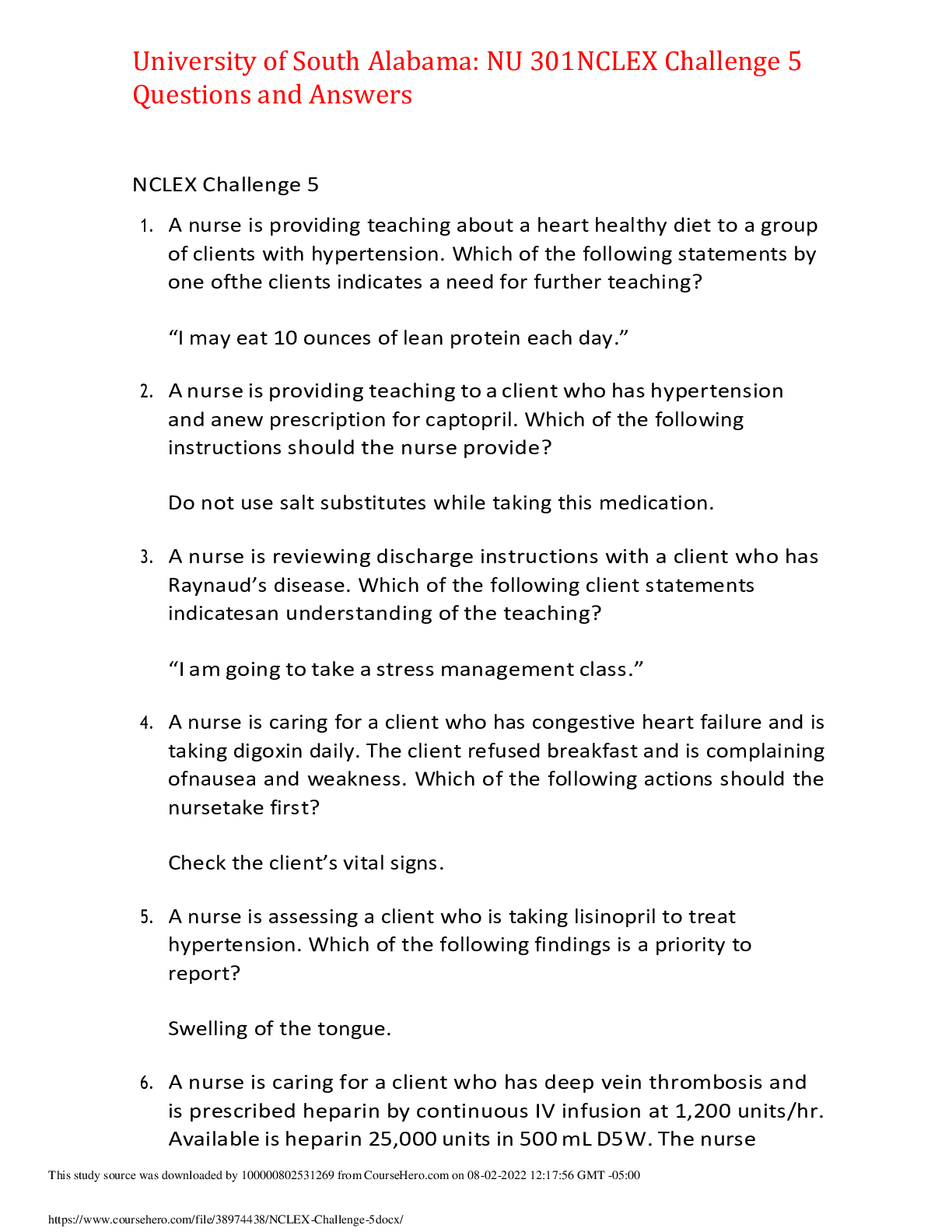

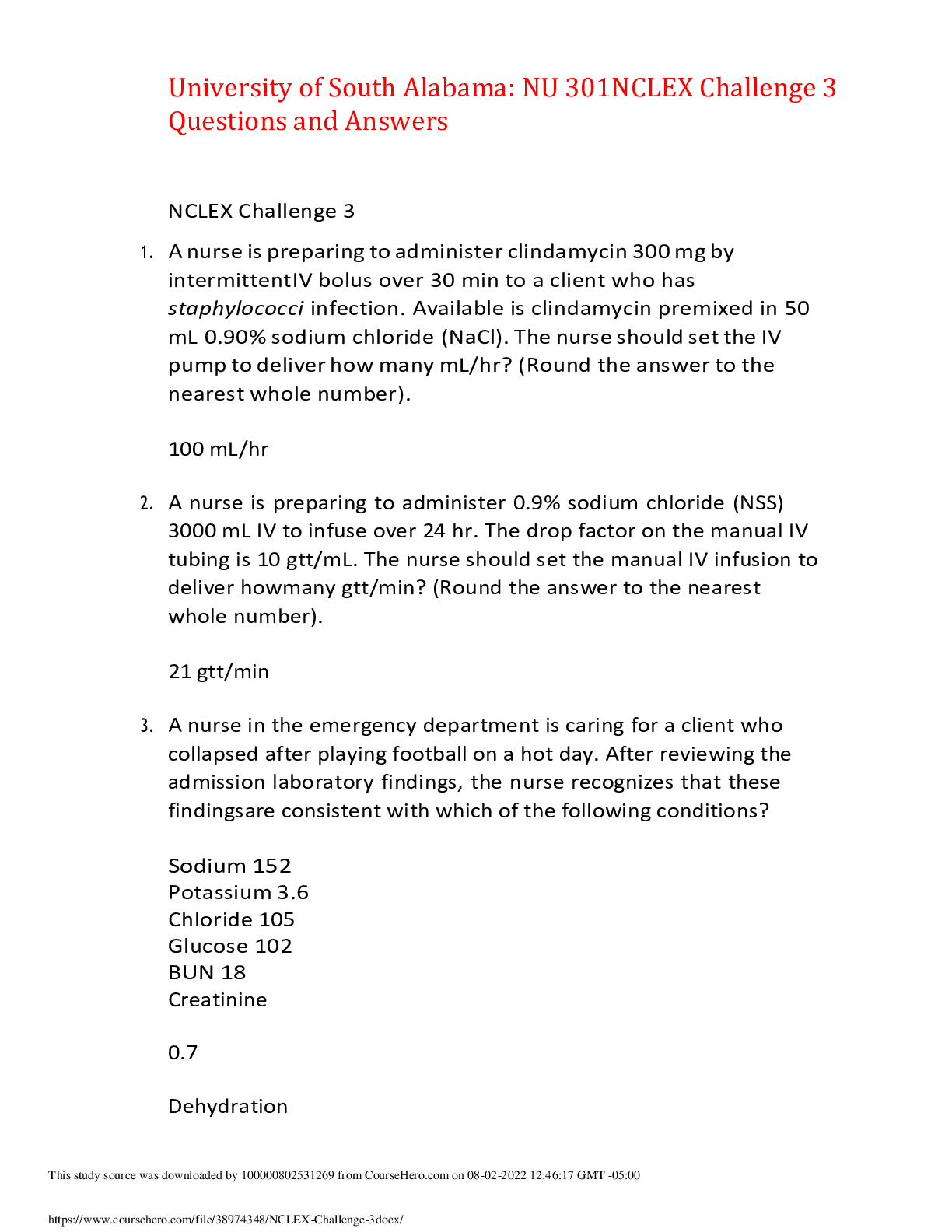
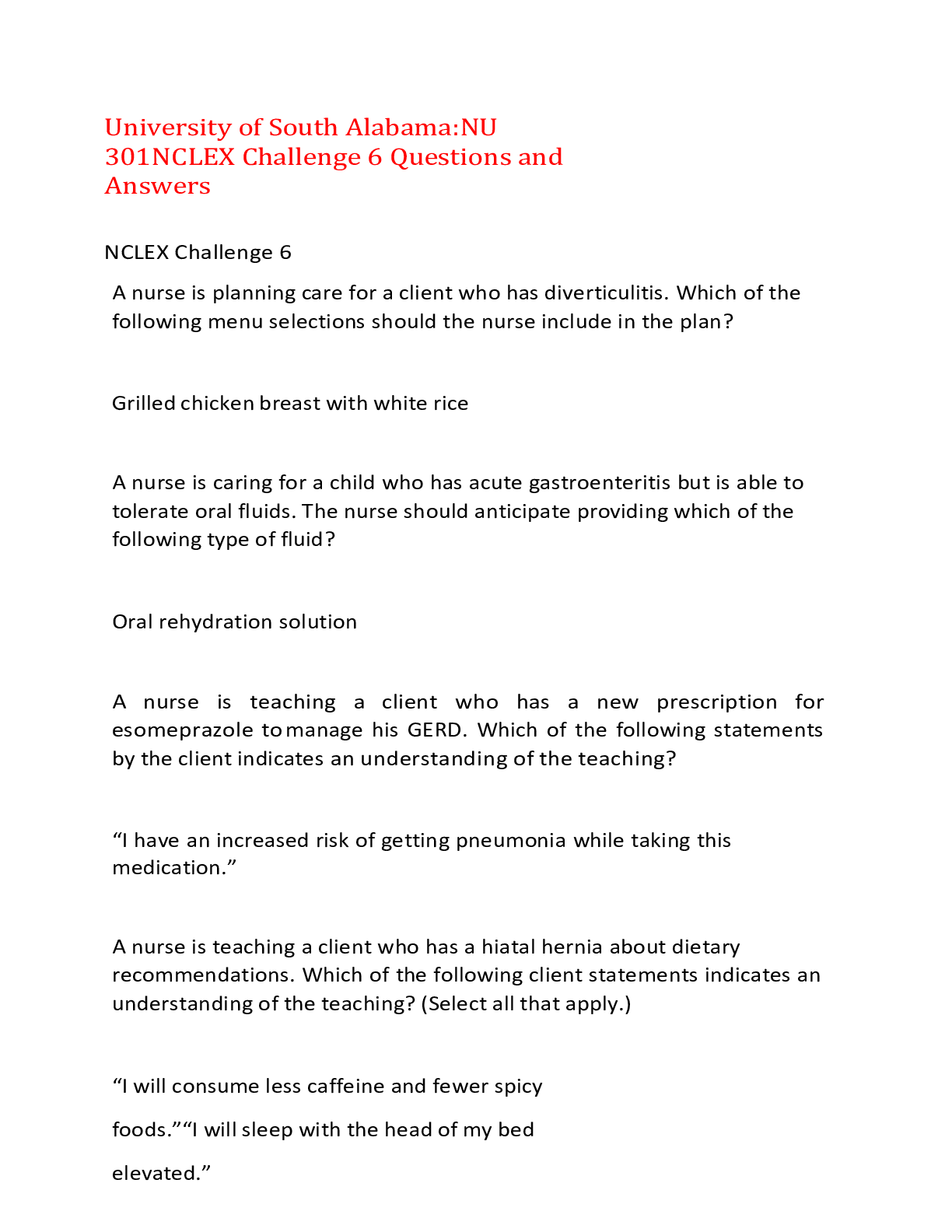
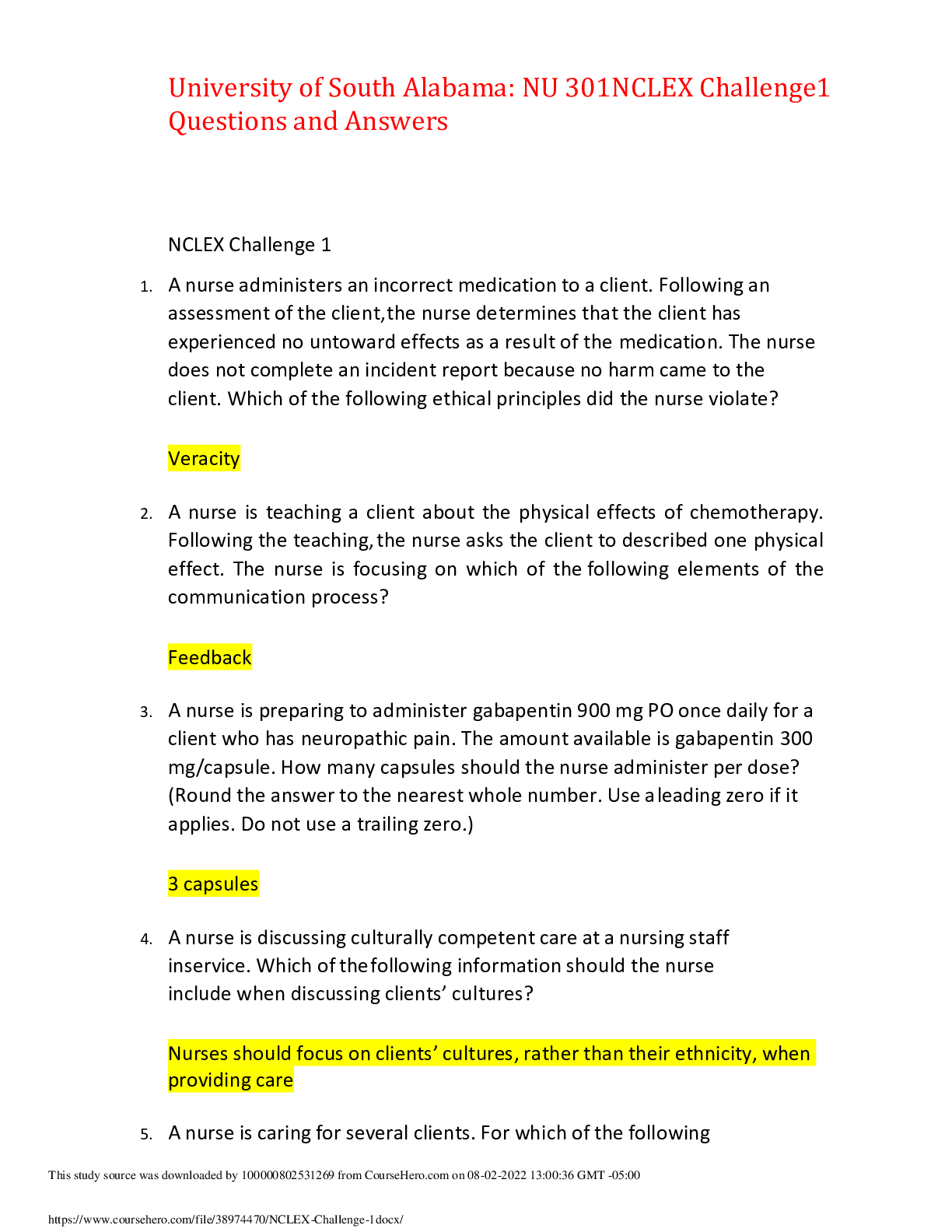

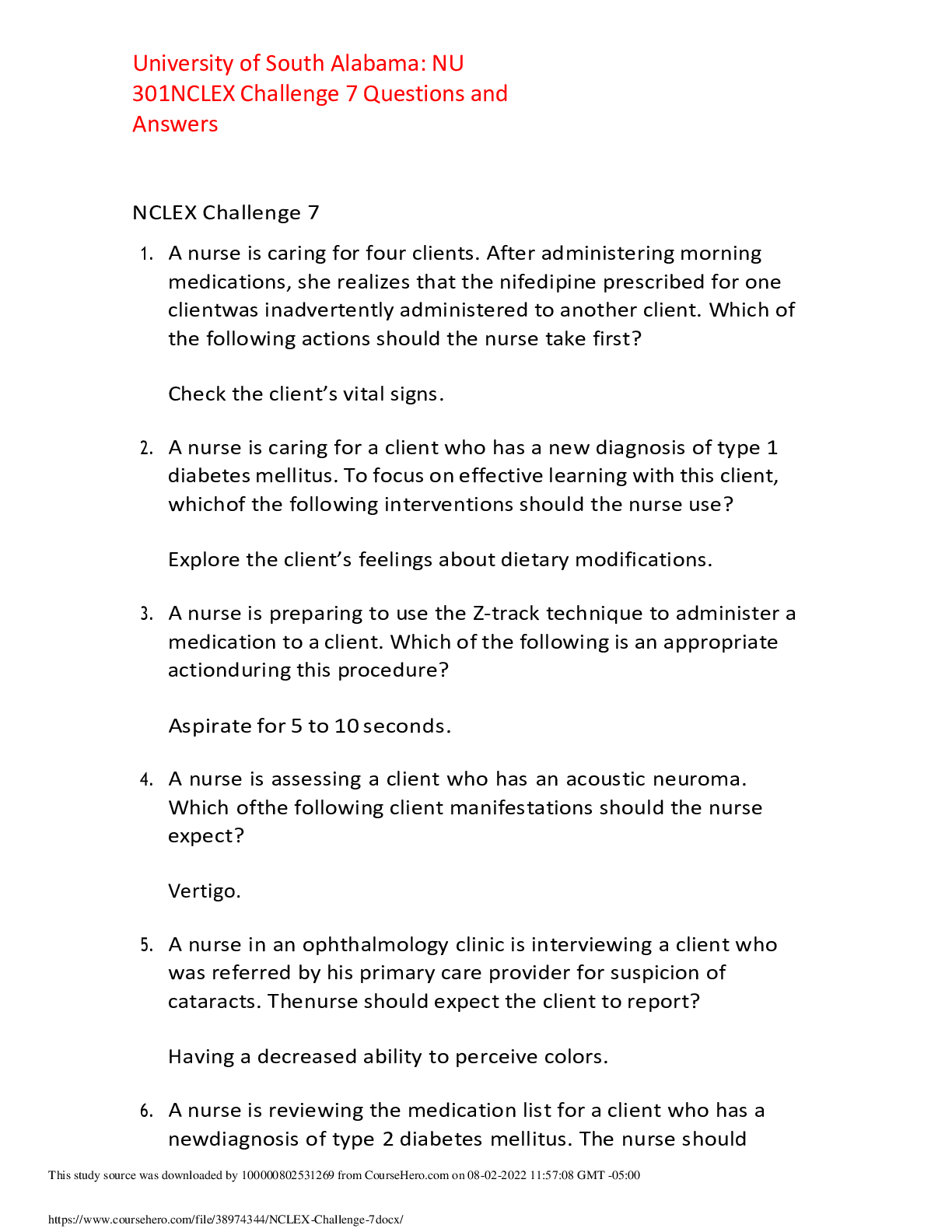
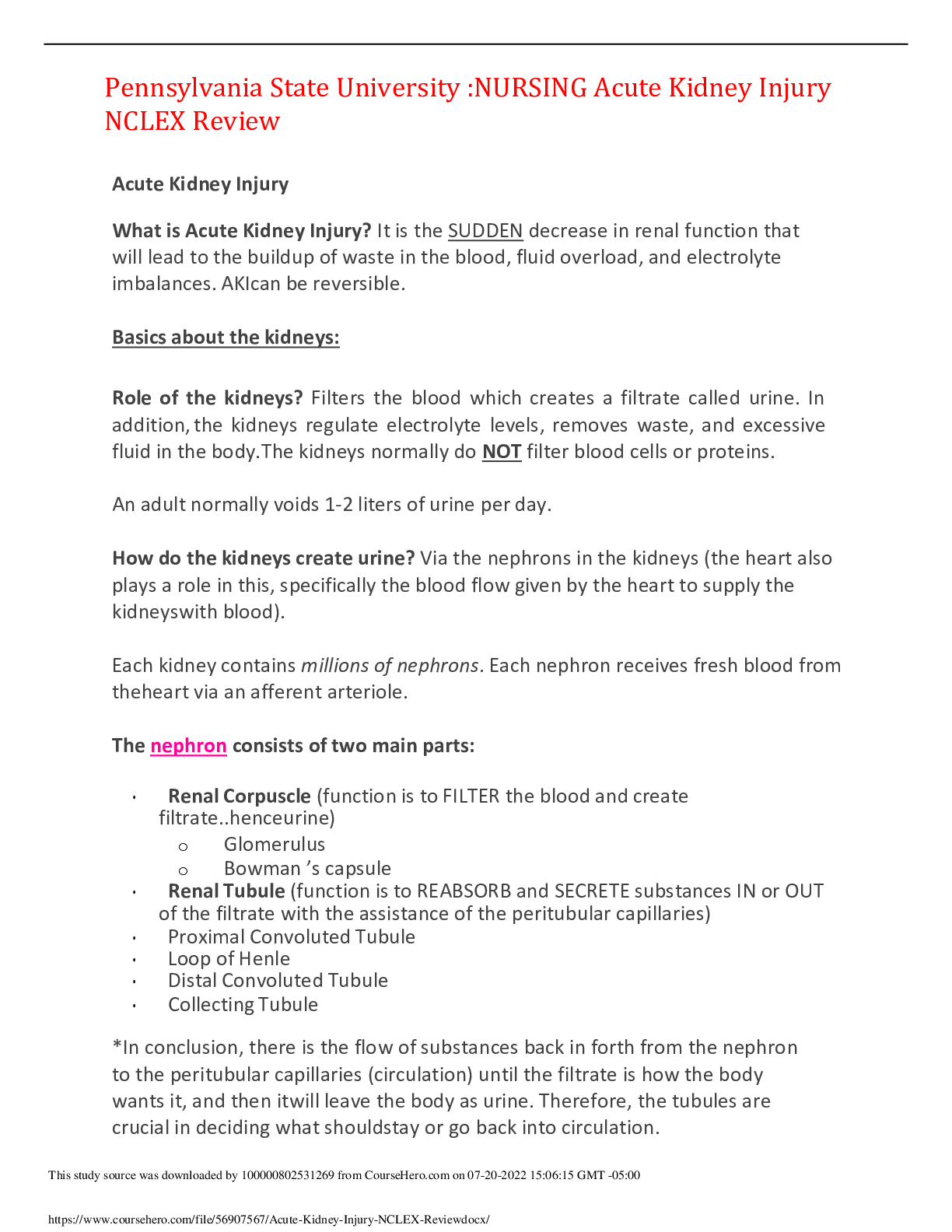
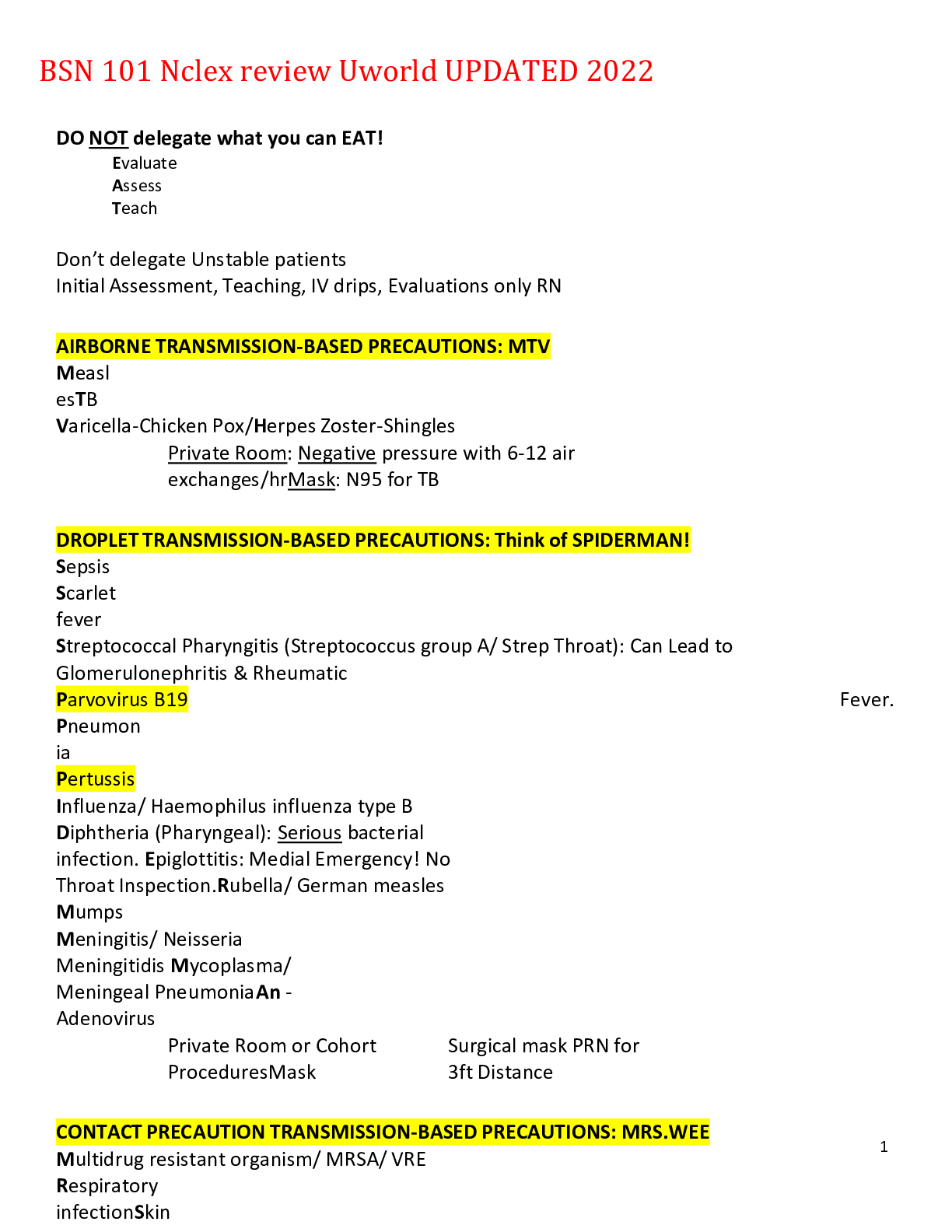
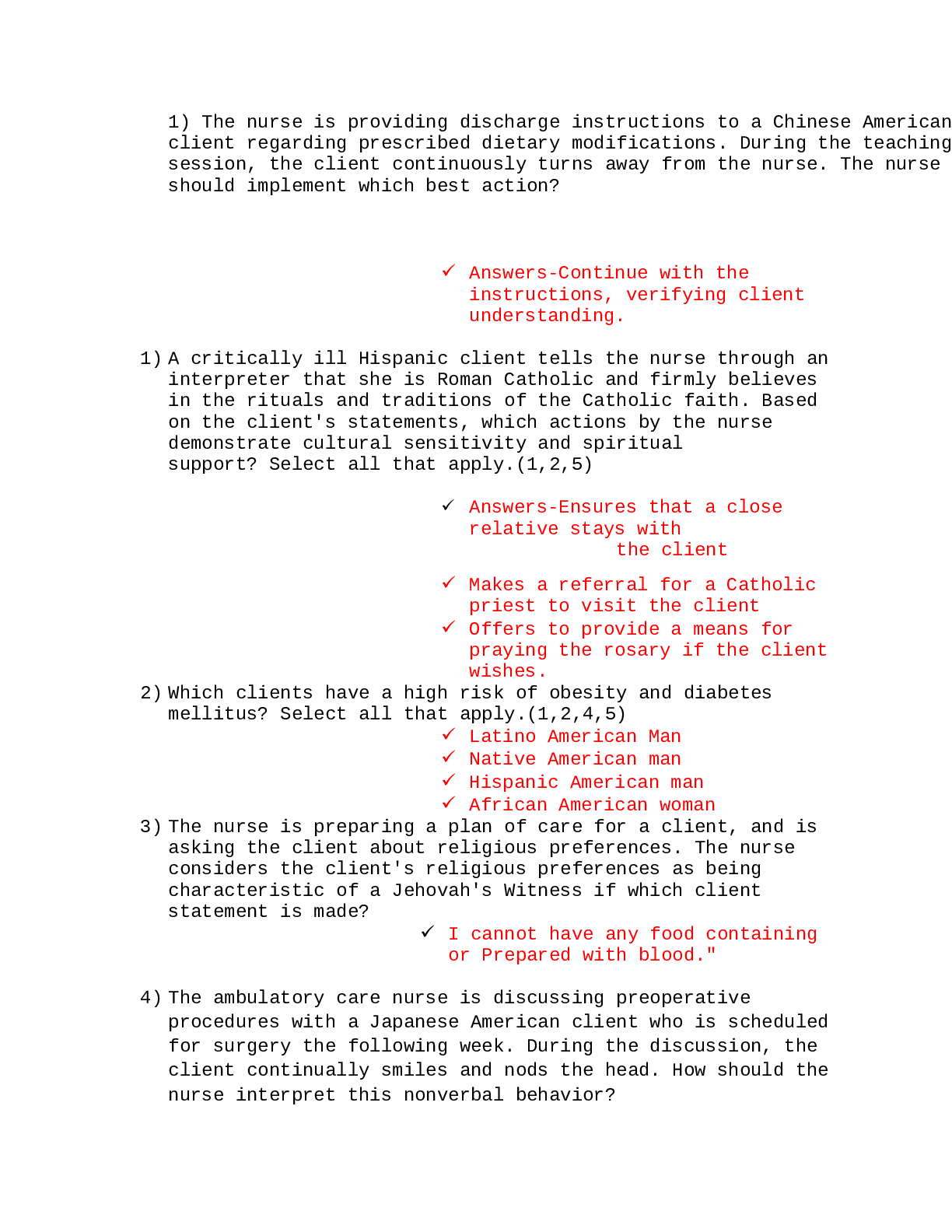
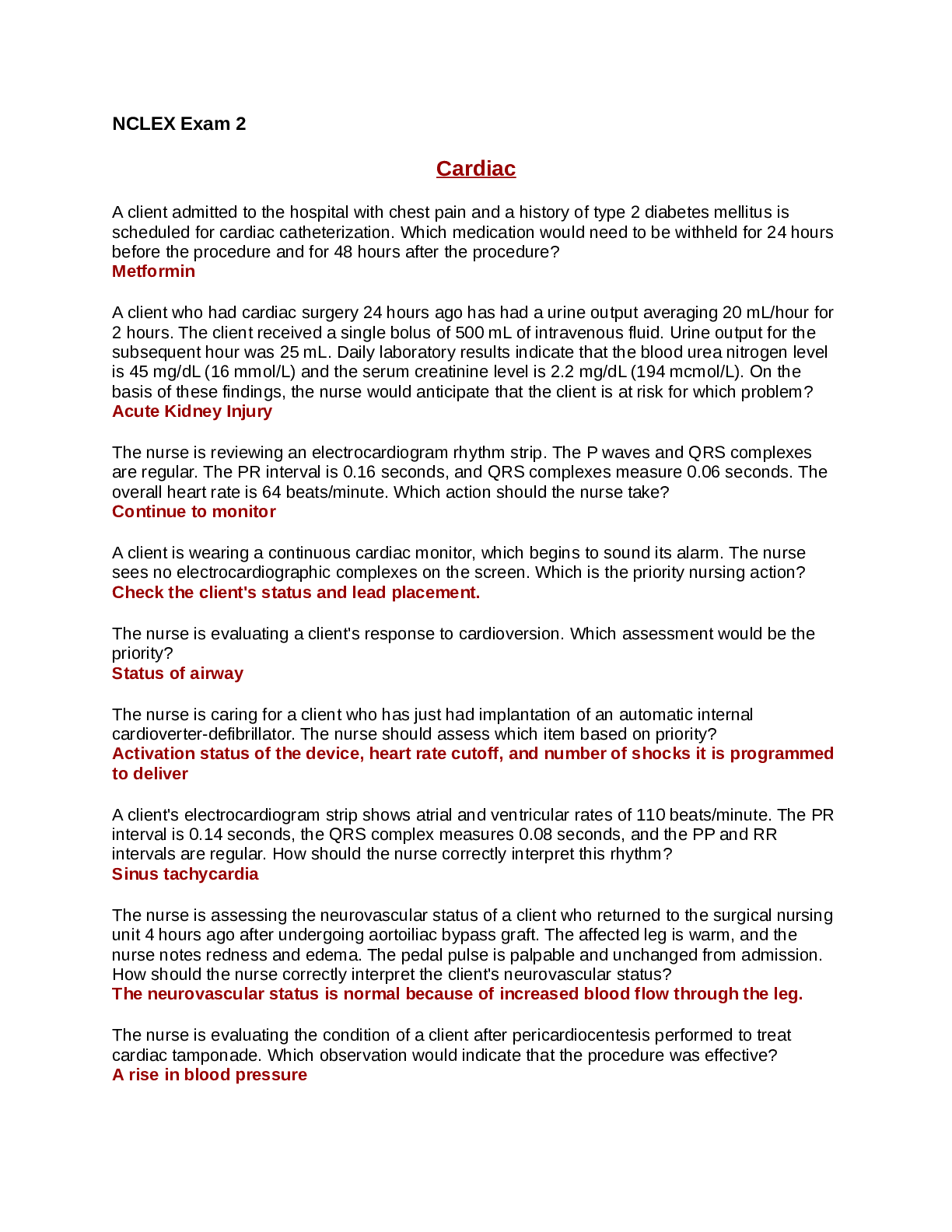
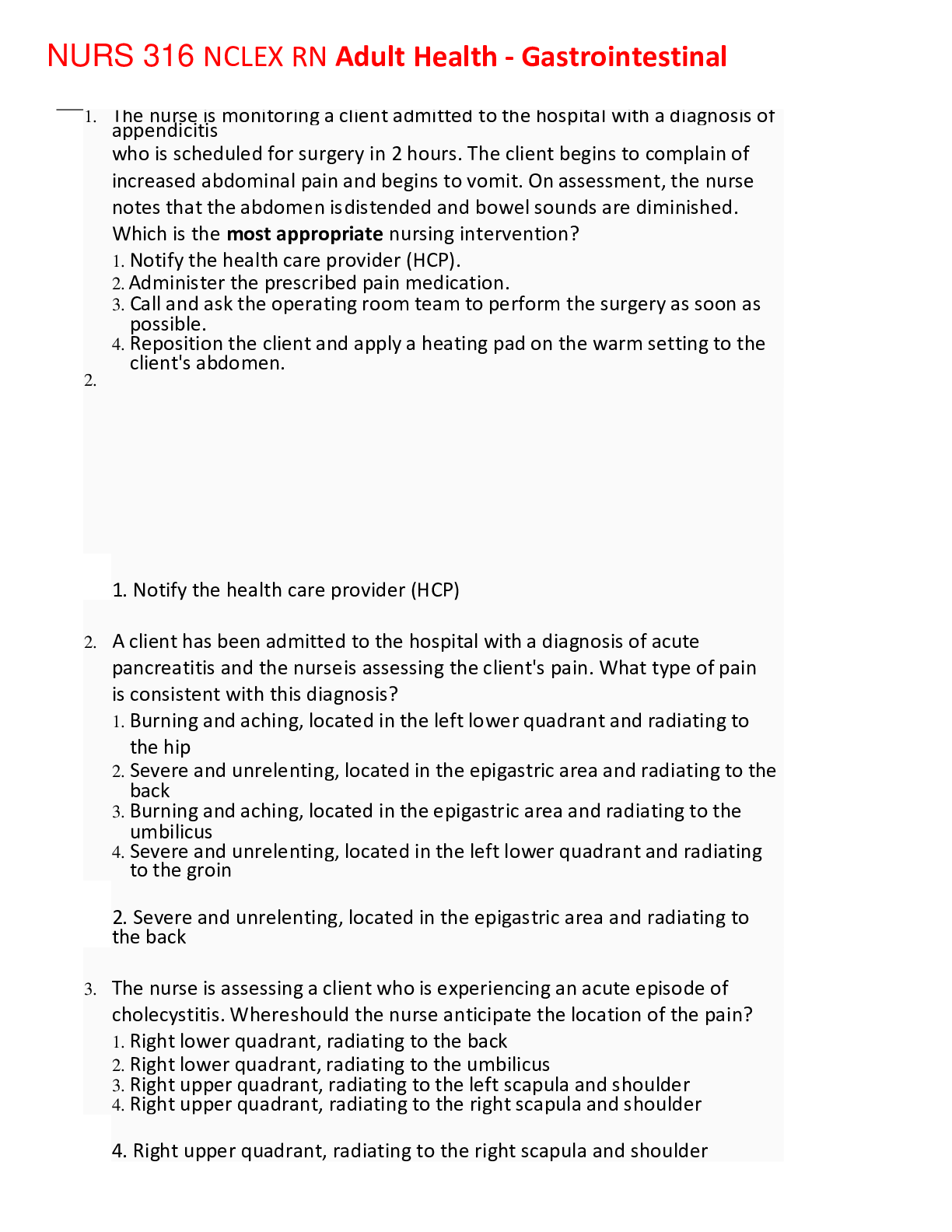
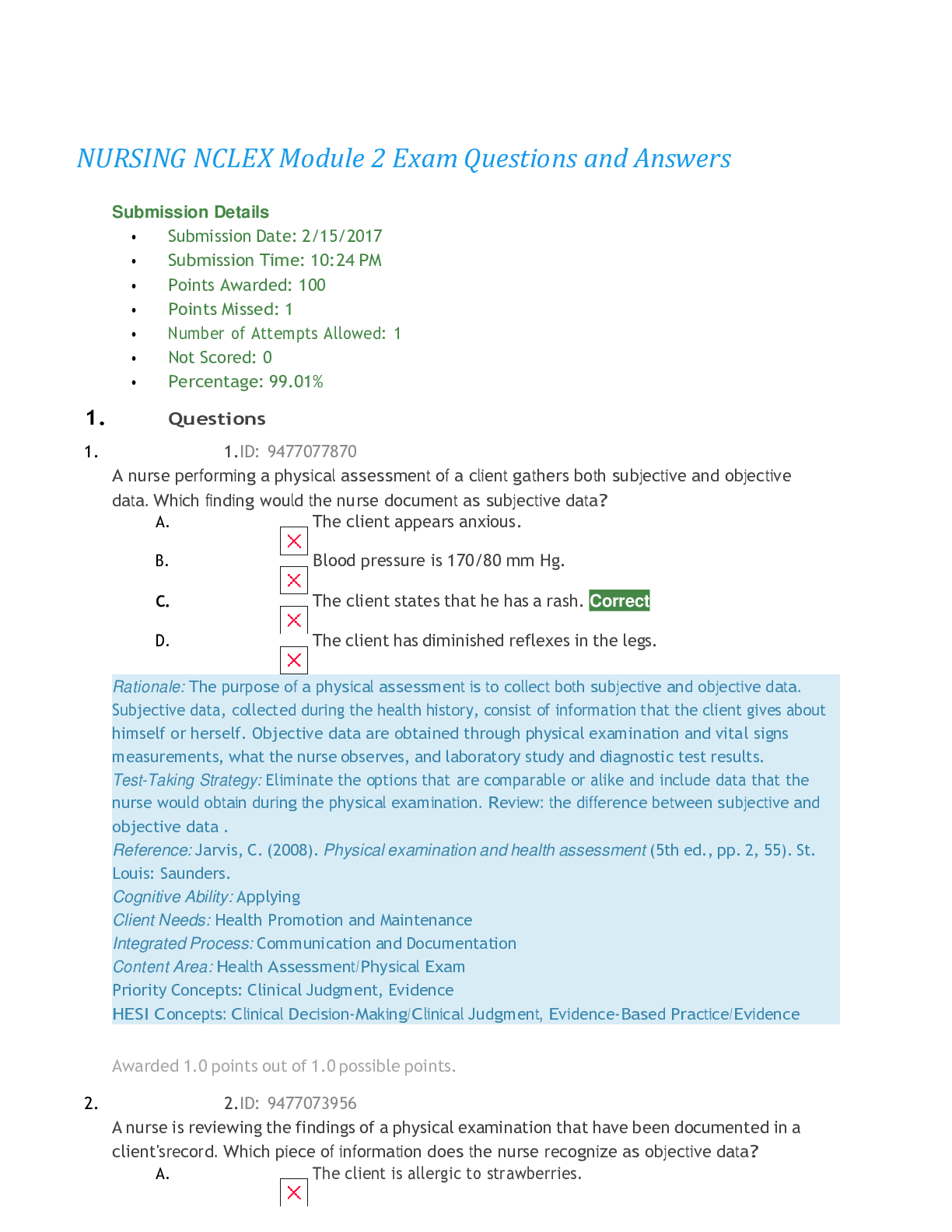
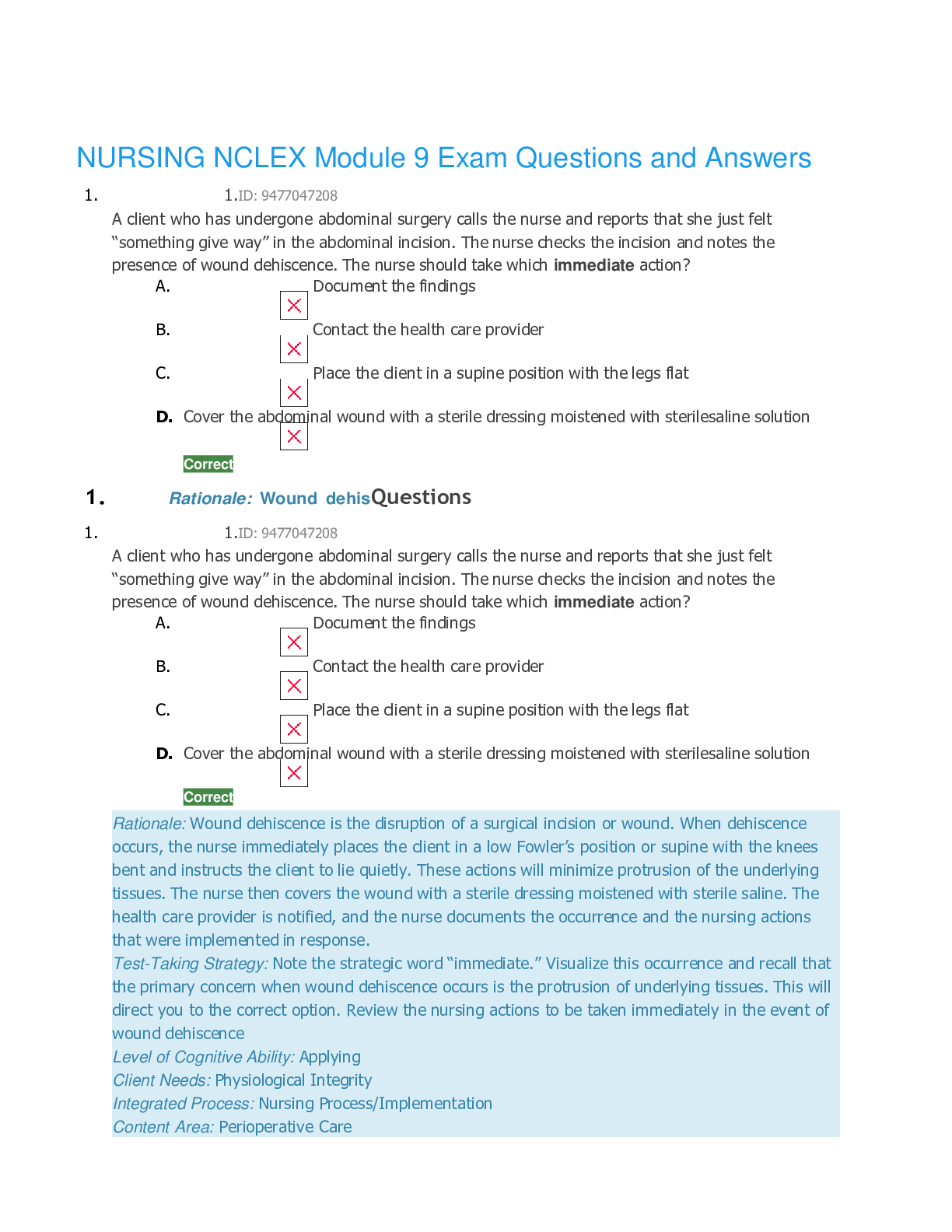
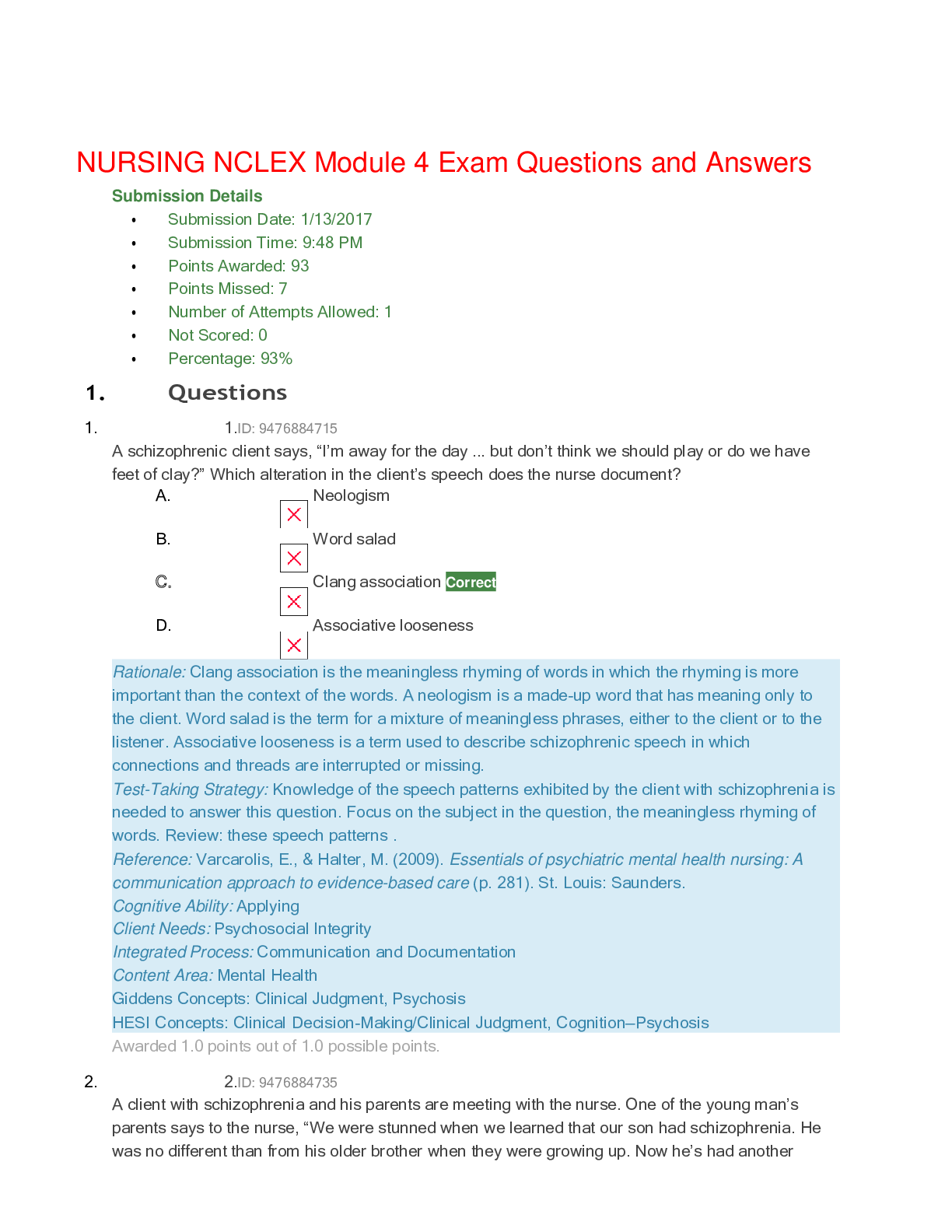

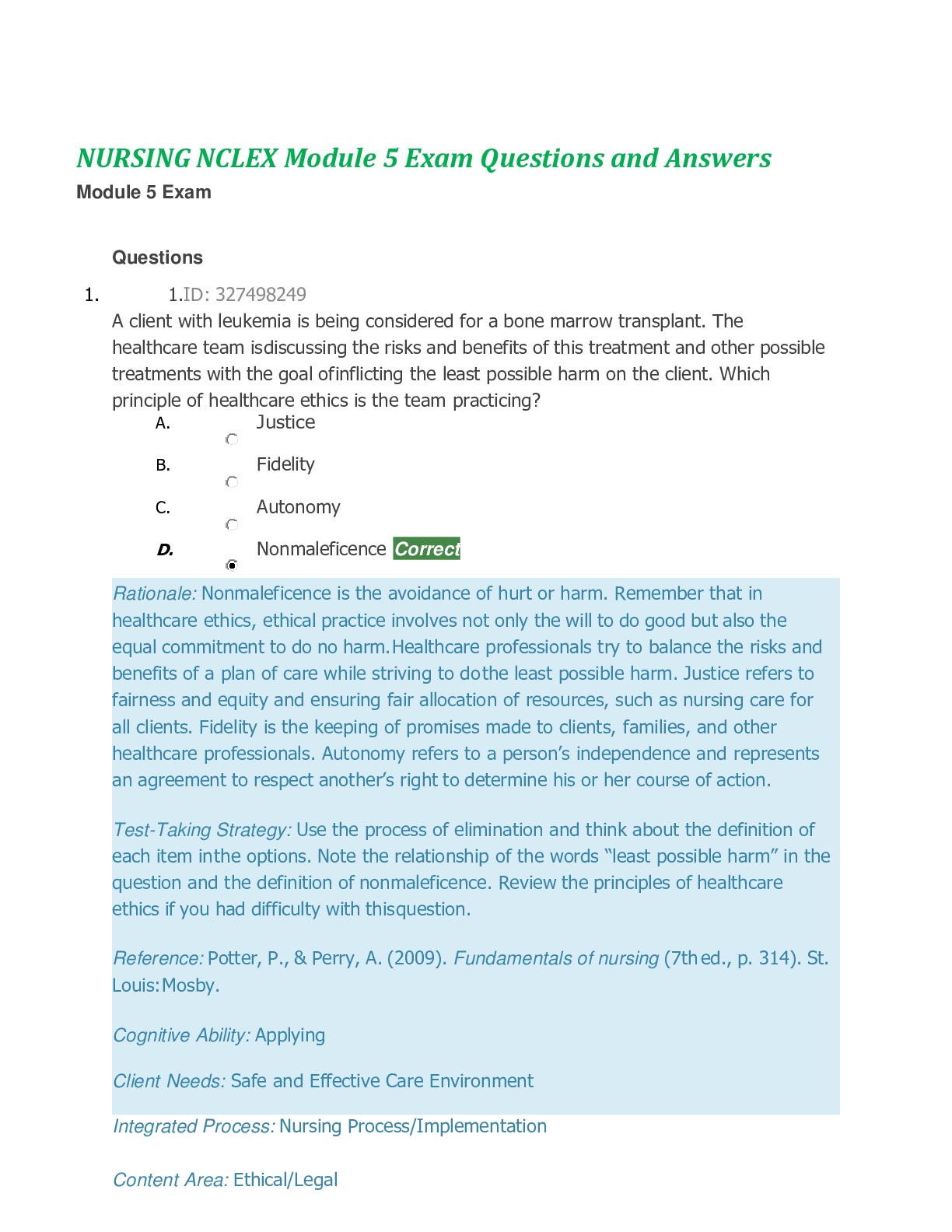
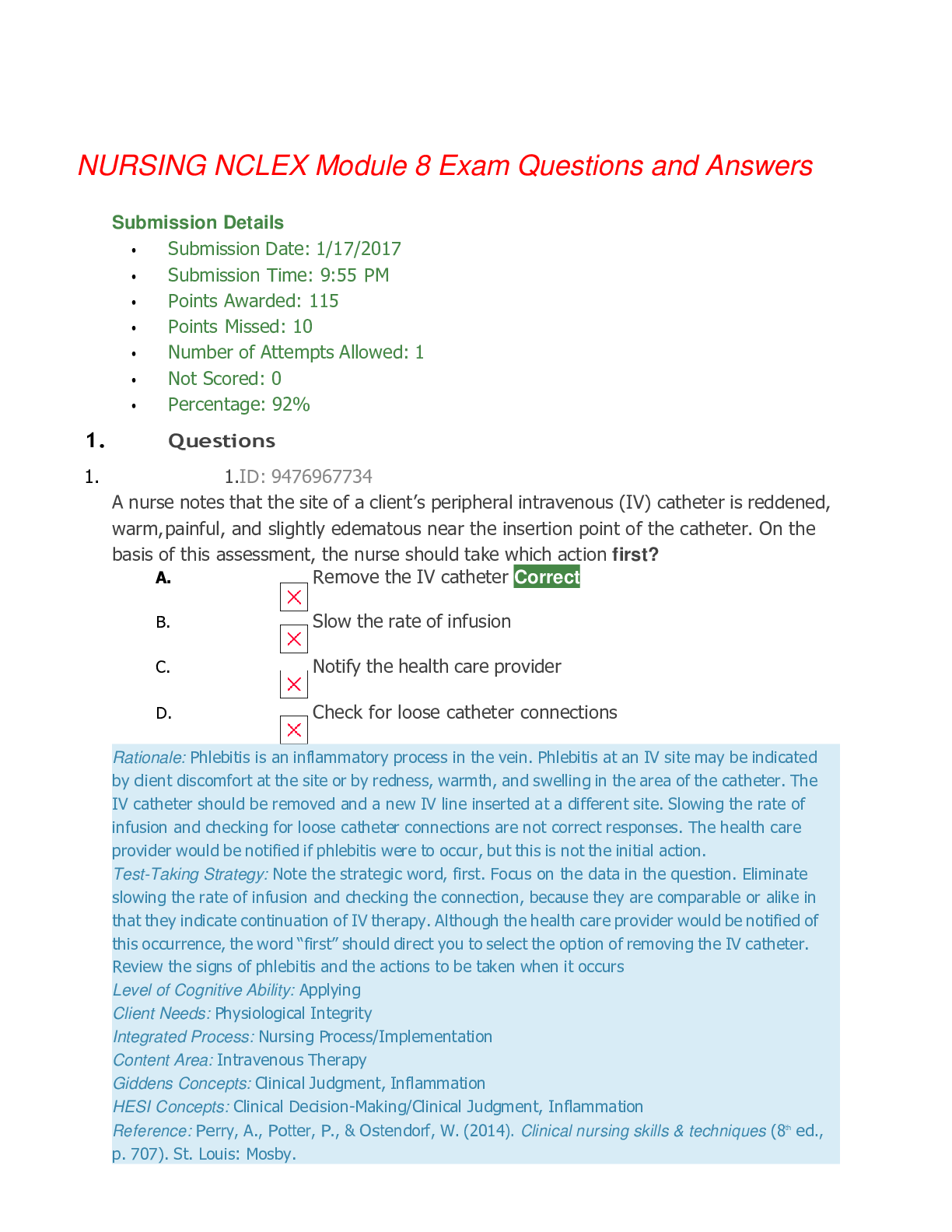
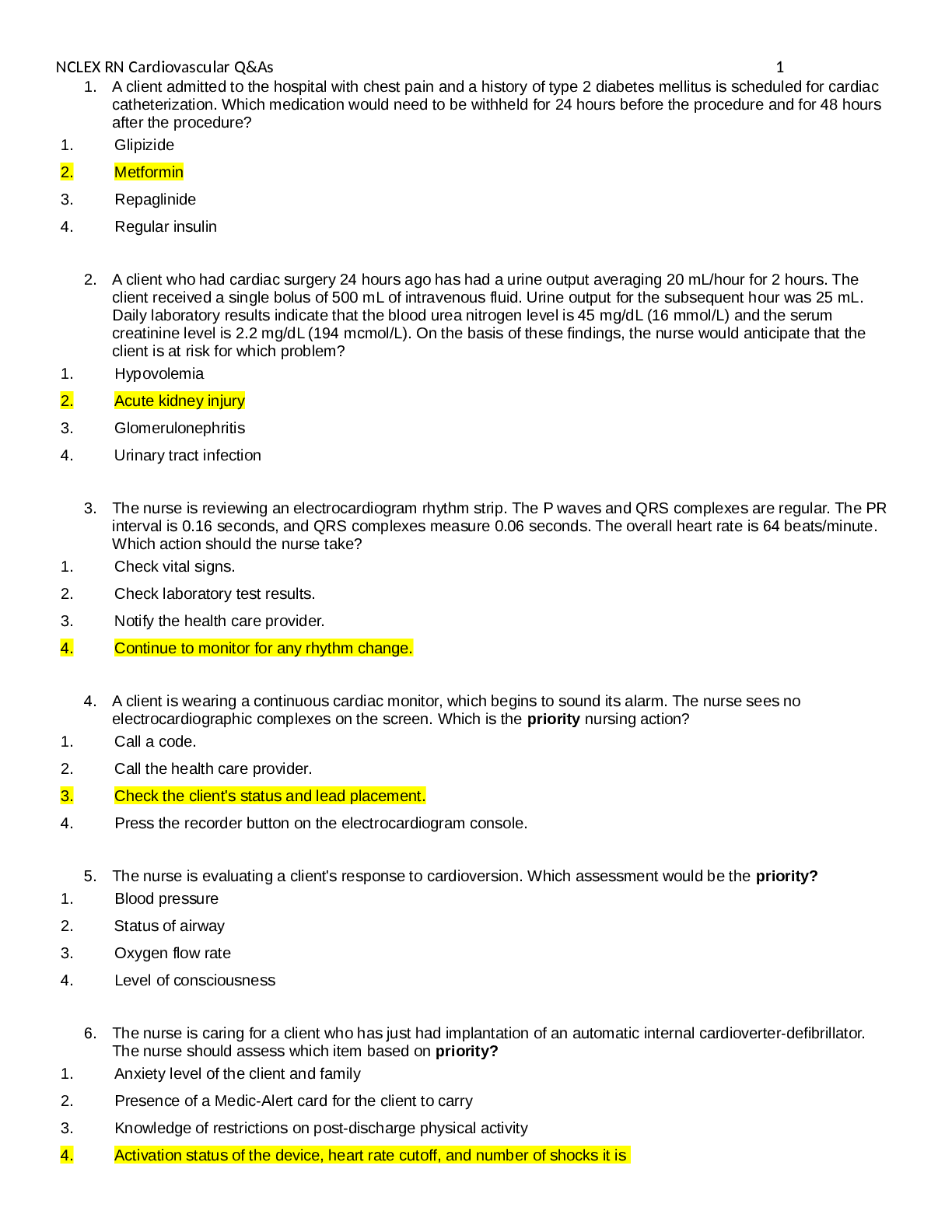
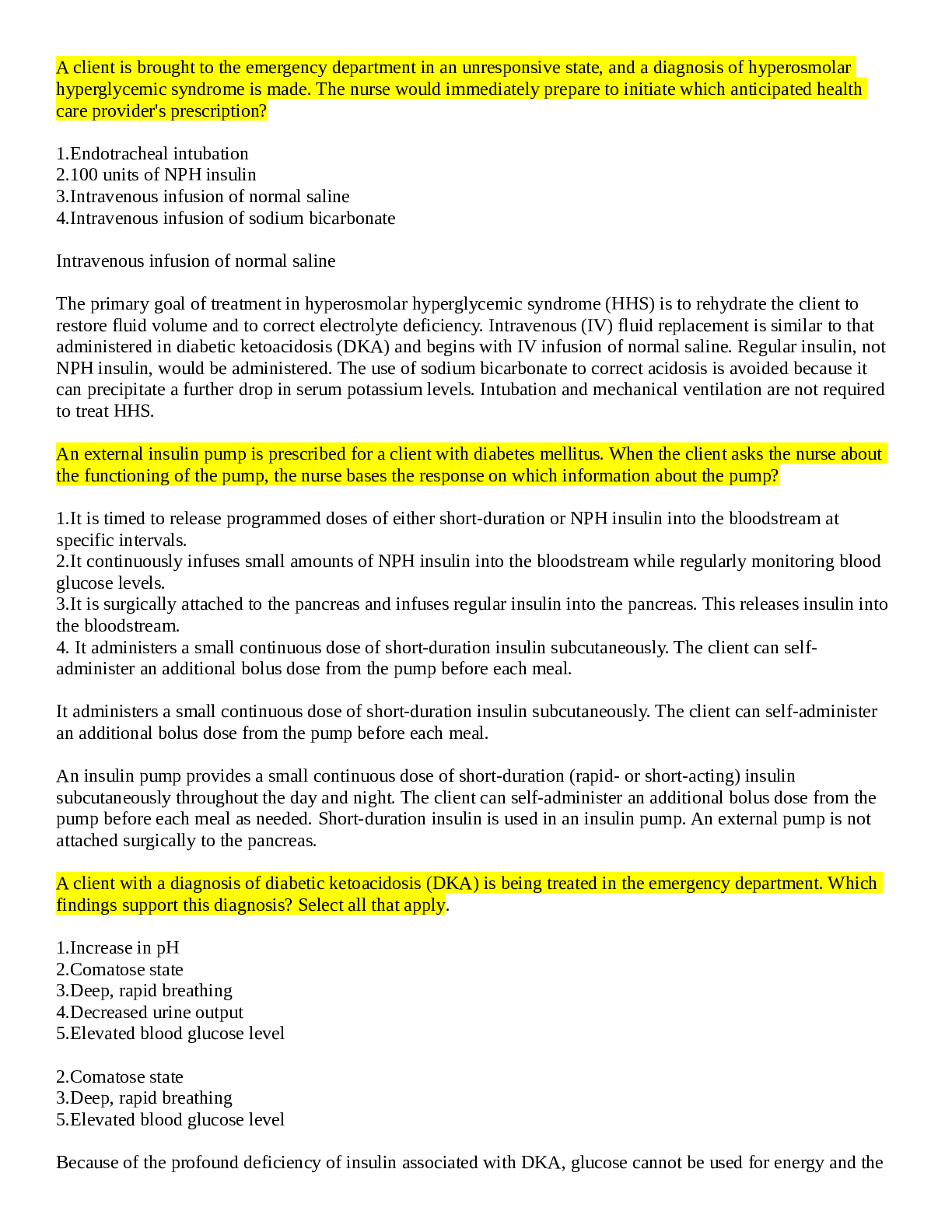
.png)
.png)
